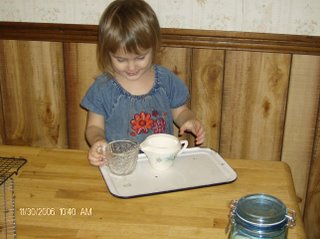MM: Practical Life Exercises are Your Friend!
Monday, January 08, 2007

I'm exploring the world of Montessori, and loving it. It is all about letting the child learn at their own pace, giving them the skills to be confident, loving people, and teaching them how to live in our world. It's very a very hands on/no worksheet curriculum. I thought I'd share my journey in implementing Montessori in our home, and maybe pick the brains of more experienced Montessori Moms!

I also like that Maria Montessori was a devout Catholic, and insisted on spiritual and beautiful things for children. She has a wonderful book, The Mass Explained to Children, that *I* learned a lot from; she frequently cites God and His design for children and families in her texts, and explicitly encourages a good, Christian upbringing including serving others, harmony, peace, love, and unselfishness - and how to teach these traits to toddlers. She encouraged training children to self discipline at the earliest age. Also, the method has been in use, successfully, for 100 years. It's not some new educational fad. It is also excellent, and easily adaptable for children with special needs. (Actually, Dr. Montessori got her start in the "special needs" world, working with "deficients" as they were called, and later the poorest and most disadvantaged children.) Her worldview is that children are fearfully and wonderfully made, and we, parents and educators, are stewards - not dictators trying to cram their heads with facts, but rather, directors guiding their hearts.
A hallmark of a Montessori-style education are the Practical Life exercises for little ones. They are exactly what they sound like - teaching children practical skills so that they can do things, correctly, by themselves.
This is not expecting them to pick it up by watching you, but deliberately teaching them the correct method for various activities, such as washing, polishing, sitting in a chair, carrying a chair (silently, not dragging it through the house like a criminal being drawn and quartered), etc.
A favorite example given in her books is that children are often scolded or reprimanded for having a runny nose, or sniffling. Yet, no one had ever taught them how to blow their nose quietly and politely! How frustrated those little ones were, constantly in trouble for something they didn't know how to fix!
Examining my mothering from a Montessori perspective has also helped me in other ways; yesterday, I taught my 4 year old how to clean under his fingernails and clip them himself. It would never have crossed my mind to teach my older boys to do this at age 4, but it is one less thing I'll have to do in the future!
Today's episode: Pouring
Teach your children how to pour a liquid, and let them practice. Believe me, you'll be glad you did! This is a wonderful skill for a child to have - basically, it's How Not To Spill. What mom wouldn't love for her toddler to master that skill?
There are several steps and methods to pouring exercises. These include:
2 glasses, transparent, same size and type. Pour dry materials, such as beans, working down to rice or sand and then progressing to liquids.
2 glasses, opaque, same size and type. Same progression.
2 small pitchers, first use dry, then progress to liquids.
Here's some links to the professionals - how to present this work:
Montessori World Educational Institute - pouring lesson
MTS Montessori Practical life album - pouring and more
Preschool Power printable pouring lesson
Flickr photo of pouring lesson
 Here's my two year old. She loves to pour!
Here's my two year old. She loves to pour!I bought two small creamers at the thrift store to practice with. Classical Montessori would have them beautiful, and matching... mine don't match, but they are ceramic and cut glass. This is also to teach the children to be careful with breakable objects. If she breaks my little 50 cent pitcher, it's a good lesson but I won't be devastated; it's good practice for later at the holiday table using real dinnerware.
The tray is also a thrift store find, but I have a stack of smallish cookie trays I got at the dollar store for all of our "small part" and messy works. I highly doubt they are any good for baking, but they are cheap (and magnetic!) This contains the mess of spilled beans or water. Another practical life skill is teaching a child the correct way to wipe up a spill!
I also like the metal trays, as opposed to plastic or wood, because it helps with control of error. Control of error means, basically, the child can determine themselves whether
 he has completed the task correctly, without relying on adults to mark off problems or let him know. For example, a puzzle has a natural control of error. If done correctly, the puzzle pieces will all fit together to make a picture. If done incorrectly, the picture will be mixed up; there will be pieces leftover; pieces will not fit neatly.
he has completed the task correctly, without relying on adults to mark off problems or let him know. For example, a puzzle has a natural control of error. If done correctly, the puzzle pieces will all fit together to make a picture. If done incorrectly, the picture will be mixed up; there will be pieces leftover; pieces will not fit neatly.The metal gives a control of error regarding handling breakable objects - if the pitcher is set down to hard, a loud noise will be heard. Control of error: there should be little, or no noise. Another control of error for the pouring exercises is, if done correctly, there will be no spills. This is much preferred to Mommy standing over the child nagging about spilling, making a mess, and taking the pitcher out of the child's hand to do it herself! The child will know, independently, if he's made a mistake.
Extra bonus for Mama - after I presented the pouring lesson, I stopped spilling my coffee. I had complained to my husband several times over the stupid coffee pot - we got a new one when we moved, as one of my moving helpers packed the old one without dumping the old coffee or grounds out of it. I was constantly dripping on the floor when I filled my cup. Must be the pot, I was sure.
No, actually, it was me not paying attention and making sure the pour spout was centered over my cup.
posted by Milehimama @ Mama Says at 1/08/2007 01:19:00 PM | Permalink |
|








